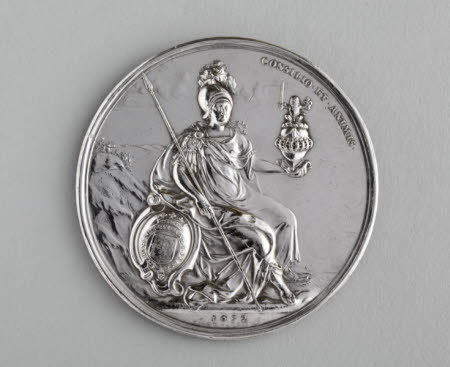Medal of John Maitland, 1st Duke of Lauderdale
John Roettiers (1631- London 1703)
Category
Art / Sculpture
Date
1672
Materials
Silver
Measurements
4 mm (Depth); 62 mm (Diameter)
Order this imageCollection
Ham House, Surrey
NT 1139625
Summary
Silver, John Maitland, 1st Duke of Lauderdale (1616-1682), by John Roettiers (1631-1703), 1672. A silver medal by John Roettiers, depicting John Maitland, 1st Duke of Lauderdale, made to commemorate Maitland’s elevation to a Dukedom in 1672. The medal shows the Duke on the obverse and, on the reverse, the goddess Minerva seated to right, leaning upon a shield, decorated with the armorial bearings of the Duke, whose helmet and crest she holds in her left hand; behind her a mountain. Above is the motto CONSILIO ET ANIMIS; in the exergue, i.e. below the main device, are the date and signature.
Full description
A silver medal by John Roettiers (1631-1703), depicting John Maitland, 1st Duke of Lauderdale (1616-1682), dated 1672, the year in which Maitland, the 2nd earl of Lauderdale, was elevated to a Dukedom. The obverse of the medal shows a bust portrait of the Duke in profile, facing right, bewigged and wearing all’antica armour with a lion pauldron (shoulder piece), over it a cloak, knotted at the shoulder. A plain rim fillet. On the reverse is the goddess of Wisdom and Learning, Minerva, seated facing right, wearing armour and over this a cloak, helmeted. She leans upon a shield, decorated with the armorial bearings of the Duke, including the Garter, whilst in her outstretched left hand she holds the helmet and crest of the Duke. At left a mountain rises in the background. At right the motto CONSILIO ET ANIMIS (‘By wisdom and courage’); in the exergue are the date, 1672 and, in cursive script, the signature of the medallist. John Maitland, 1st Duke and 2nd Earl of Lauderdale, was a Scotsman who during the Civil War and its aftermath fought ferociously to try to persuade King Charles I and his son Charles to accept Presbyterianism. After the final defeat of the Royalist cause Maitland went into exile but with the Restoration in 1660, he became a close friend and advisor to King Charles II. He had powerful interests in both Scotland and England and was a member of the so-called Cabal ministry, five royal advisers who dominated politics between 1668-73. In 1672, after the death of his first wife, Lauderdale married the widowed Elizabeth, Countess of Dysart. On 2 May 1672, he was created Duke of Lauderdale and Earl of March and, on 3 June was admitted to the Order of the Garter. The medal by John Roettiers was made to commemorate Maitland’s elevation to the Dukedom and to the Order of the Garter. John Roettiers grew up in Antwerp, the son of a goldsmith. In 1661, King Charles II invited him along with his brother Joseph to come to London to work for the Royal Mint, where he quickly became one of the Mint’s chief engravers and was subsequently joined by his sons Joseph and Norbert. John Roettiers is regarded as one of the finest engravers ever to work at the Mint. The present medal is notable for the economy of the design. The dies for the medal, which is relatively common, are in the British Museum. Jeremy Warren November 2021
Provenance
By descent, until acquired in 1948 by HM Government when Sir Lyonel, 4th Bt (1854 – 1952) and Sir Cecil Tollemache, 5th Bt (1886 – 1969) presented Ham House to the National Trust. Entrusted to the care of the Victoria & Albert Museum until 1990, when returned to the care of the National Trust, to which ownership was transferred in 2002.
Credit line
Ham House, The Dysart Collection (purchased by HM Government in 1948 and transferred to the National Trust in 2002)
Marks and inscriptions
Reverse: Legend: CONSILIO. ET. ANIMIS Exergue: 1672/Joan. Rott. F[ecit] [John Roettiers made this]
Makers and roles
John Roettiers (1631- London 1703), medallist
References
Hawkins, E. (ed.) Franks, A.W. and Grueber, H.A: Medallic Illustrations of the History of Great Britain and Ireland to the death of George II, 2 vols,. London, 1885, vol. I, p. 550, no. 208 Eimer 2010: Christopher Eimer, British Commemorative Medals and their Values, London 2010, p. 58, no. 248. Rowell 2013: Christopher Rowell (ed.), Ham House, 400 Years of Collecting and Patronage, Yale University Press, New Haven & London 2013, pp. 121-22, figs. 106-07



